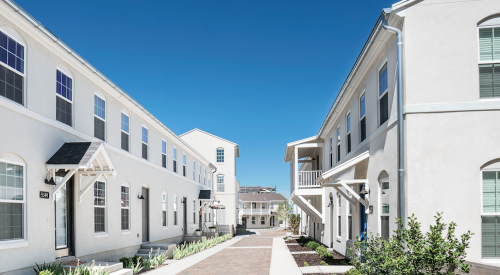Those words are the foundation for Clayton Preston and Greg Ramsey, architects and partners in Village Habitat Design. Their theory--and goal--is to replace conventional real estate development with a new model - the conservation community. In their model, land isn’t subdivided so that each home is set apart and surrounded by its own zone of green grass. Rather, houses are clustered so less land is disturbed by development. The remaining natural areas are used for recreation, wildlife habitats and agriculture.
The tenets of a conversation community, which Preston also calls the new American Village, are:
- It preserves a large portion of the land for woodland and agriculture.
- It is pedestrian (walkable). Automobile space is subordinate to human spaces.
- It supports work/commerce in the community.
- It has a greater range of home prices (than conventional suburban developments).
- It promotes daily interaction of the residents.
Sounds noble, but how profitable can this be, you wonder? Done right, the answer is very profitable. The latest case for this development philosophy is East Lake Commons, an 18-acre infill community in Dekalb County, Ga., just four miles from downtown Atlanta. This 67-unit conservation community incorporates all the basic features. For instance:
- Nine of the 18 acres--50% of the total site--is preserved as open space. This undeveloped land includes a six-acre garden for residents, a stream buffer and a small woodland area with nature trails.
Developing the property this way wasn’t the original plan. At the outset, the parcel was zoned for 72 units on 7500 sq. ft. lots. Ramsey and builder/developer Jack Morse reduced the number of housing units to 67 and worked to obtain a zoning variance that allowed all the homes to be placed on just half the land. "Offsetting density zoning prevents sprawl and preserves and connects green space," explains Preston.
- Cars at East Lake Commons are contained in parking areas on the periphery of the living spaces. "There isn’t the usual street view of garages and driveways throughout the neighborhood," explains Preston. "Clustered parking takes away that streetscape and transforms roads for cars into pedestrian living lanes."
Clustering the residences at East Lake Commons also brought buildings close enough together that walking is a practical and enjoyable way for residents to get around. "Getting people out of their cars does a lot to foster the sense of community so many home buyers are seeking today," says Preston. "Neighbors know one another because there are so many encounter opportunities when people walk instead of ride throughout the neighborhood."
In this pedestrian-oriented community, there is a natural progression from the public to private spaces for residents. "As the streets move further into the community there is little reason for anyone but homeowners to be in neighborhood," explains Preston. "Visitors to the community are visible to the residents. That is real security and real privacy."
To keep the walking environment viable and create a sense of community for residents, East Lake is divided into two distinct neighborhoods. Each has its own parks and gardens, and green buffers separate one from the other and both from the surrounding neighborhoods and commercial district.
Pedestrian planning in a conservation community goes beyond just creating walking trails and including a few benches. It considers how far it is comfortable and convenient to walk for different activities. As a general rule, Preston says the higher the density the better the pedestrian environment. The optimum density is about 15 to 30 units per acre. At this level, within the walking environment there is space for plazas, courtyards and small gardens.
- Conservation goes beyond just preserving land; it involves changing the way neighborhood residents live and work. Central to this effort is incorporating work and commerce within the community rather than a car trip away.
This aspect of development proved problematic at East Lake Commons. While Atlanta zoning allows for home-based occupations, it doesn’t allow for combined retail and residential in the same development. However, even within the zoning restrictions, there are opportunities for community-based work initiatives at East Lake Commons. One resident makes his living as the gardener, tending the two organic gardens that are a part of the community. Still another builds on his labor and processes the produce into jams, jellies and relishes. And, like everywhere, there are a growing number of tele-commuters that use modern communication technology to work from home.
- The last element of a conservation community - a greater range of home prices and housing options - is certainly evident at East Lake Commons. In Phase One the lowest priced unit is a two-bedroom, 1500 sq. ft. townhouse that initially was offered at $85,000. Currently this same model is selling for $112,000. At the upper end is a four-bedroom semi-custom single family home base-priced at $235,000. Construction on Phase I is nearly complete and Phase II completion is targeted for summer of 2000.
"The diverse housing stock--and thus the diverse buyer groups--are a real plus at East Lake Commons," says Morse. "It’s created a lively community that is filled with people throughout the day." In phase one the buyer profile includes single women, young families and empty nesters, both married and single.
The diverse housing inventory and price points also has erased any need for marketing. To date, most sales have been word-of-mouth referrals. "We really haven’t had to do any advertising," says Morse. "To the buyer looking for a community without the usual long Atlanta commute, we’re the only game in town."
Builder/developer Jack Morse says East Lake Common tries to balance "intentional community with sustainable design and affordability. It’s a message that really resonates with today’s home buyer."












